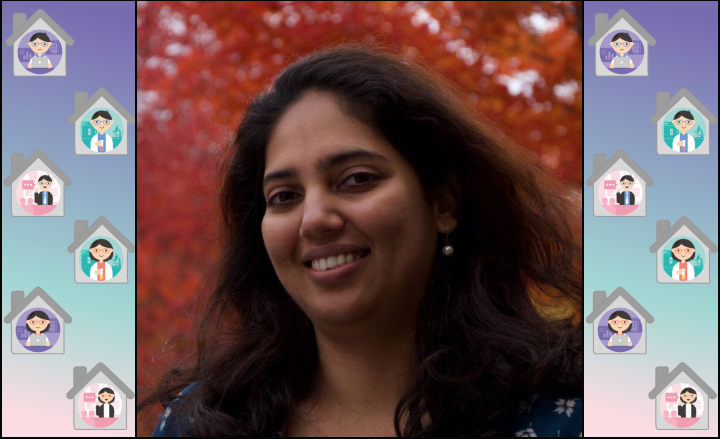In this series, we ask scientists from different backgrounds, disciplines and career stages to reflect upon their life in lockdown and how it has influenced how they approach doing science. In this article, Mayuri Rege from Ramnarain Ruia College, Mumbai, writes about how the lockdown has transformed scientific networking, especially for those for whom international travel was always a barrier. This article was first published on COVID Gyan.

Although I have a PhD, unlike the real doctors in my family, I am not a COVID warrior. The privilege of being able to work from home has given me the time to reflect on how to turn this pandemic into an opportunity to cultivate my network and advance my science.
At the beginning of this lockdown, my mental state had temporarily become one of a (novice) housewife. There’s absolutely nothing wrong in being one; it’s simply not something I have chosen to do with my life. Despite having a spouse who helps out equally, there always seemed to be a never-ending list of things to be done around the house – dusting, zadu pocha (sweeping & mopping), grocery shopping and disinfecting, cooking, laundry, and cleaning the dishes. Annoyingly, staying at home all day seemed to bring to the fore new chores that I somehow hadn’t noticed before. Although I figured out protocols to grapple with the chores efficiently, I was starting to have serious science withdrawal symptoms and an existential crisis.
For an experimentalist, being away from the lab for such a long time is unfathomable. Be it for vacations, conferences or emergencies, lab members stick together and help coordinate experiments to keep things moving in the lab.
While necessary to contain the pandemic, the lockdown has forced scientists to work from home and pause all experiments (unless you are Steve Henikoff). Without an end in sight, it can be demoralising to scientists, especially those on the cusp of graduation, applying for jobs, or submitting that final revision of a manuscript.
As many might suggest, one can use this time of isolation to dive deep into the literature and finish writing/submitting manuscripts or grants. But after this initial phase, you start to miss one of the best parts about being a scientist — discussing and brainstorming ideas and hypotheses with other smart people, which is what moves the field forward. These were previously done via in-person meetings but the COVID-19 situation has completely disrupted this mode of interaction.
Thankfully, a handful of pioneers embraced the situation to come up with innovative ways to maintain connections within the scientific community. Some large conferences (like the TAGC2020) decided to switch completely to a virtual mode at short notice (although the original conference was 1.5 years in the making). Similarly, motivated individuals and universities started virtual journal clubs/seminar series related to their field of interest to keep the community abreast of the latest research and to catch up with friends (here is an example). Slack channels, Discord servers and Zoom meetings popped up discussing a wide spectrum of topics from protocol troubleshooting (for when we return to the lab) to virtual happy hours. It almost appeared as though if your field didn’t have an online webinar series, was it really a field at all? These interactions were what kept my sanity and identity as a scientist alive during those strange times.
This approach of science without borders has been a complete game-changer, particularly for those of us not physically located in an international scientific hub. Young trainees from all over the world can now get ‘virtual’ exposure to leaders in the field more frequently than before. Such platforms also offer greater visibility to younger scientists gearing up for the job market and help build networks to collaborate with established scientists in the field.
This also provides our students with an opportunity to observe and interact with their peers from other countries. This can be very helpful in driving home the fact that their circumstances and abilities are not very different, and that they can perform at par with those in developed countries given the right attitude and strategies. This peer-to-peer setting overcomes inferiority complexes or parochial attitudes more effectively than a sermon from their teacher.
The pandemic has forced us all to test-drive the concept of virtual conferences, something that academics have hotly debated in the past. Not surprisingly, the virtual editions of conferences have seen up to three times the participation and included people from underrepresented countries across the globe. Obviously, there is significant effort involved on the part of the organizers who volunteer to host these online events – if you are one, we salute and thank you for the service you are providing to the community! This is a move towards more inclusive open science, and I hope high-quality online communities continue to grow in the post-COVID-19 world.
For those who might be sceptical of this transition, recall another recent paradigm shift — that of scientists adopting preprint servers to post their latest research. Making publicly funded science freely accessible has catalysed discovery and propelled us towards rapid solutions to this pandemic in the form of diagnostics, vaccine candidates and promising drugs.
Analogous to this, providing the option for virtual participation in conferences will reduce the disparity in participation from underrepresented communities, among other benefits including a reduced carbon footprint. Sure, there is no replacement for in-person meetings — so hybrid meetings, that allow in-person as well as virtual attendance, may be the way to go in the future.
Ironically, social distancing measures implemented during this pandemic have ended up bringing scientific communities closer. For the first time in the history of my generation, a singular unifying event is making scientists around the world seek out ways to connect with each other exclusively through the digital mode, opening up new conversations.